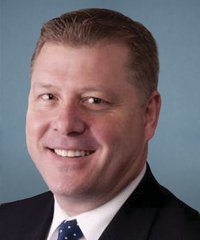
Raised in an Air Force family, U.S. Representative Rick Crawford has lived all over the United States and in England. His parents instilled in him a devotion to service from a young age. Those simple life lessons have remained with Rick, and are at the forefront of his mind when working on creating a more prosperous America for future generations.
Education and career training are lifelong, dynamic processes as unique for each individual as their fingerprints. So why is our educational system structured as if there is a system of education and a path to employment that works for everyone? Students have been placed on a single path, an assembly line that leads to a four year college. In this education factory, grades and standardized testing have undermined creativity and innovation. Students who don’t thrive in this mold and either can’t afford college or don’t want to go, are largely forgotten. And those who even make it to the end by graduating college aren’t necessarily well equipped, either for their own personal goals or for the needs of the modern economy. Generations of students have been pushed towards the same end goal without much attention given to what happens once they get out, or to those who never go to college at all.
We desperately need an updated education system, a flexible model that better supports our students, and in turn supports the needs of a highly technological, complex, and skill based economy. Today, the needs of the market increasingly outpace the abilities and curricula of our education system. Businesses across the country, but perhaps most notably those in the energy, manufacturing, healthcare, and the technology startup sectors are hungry for properly trained and skilled candidates. Many of these companies don’t even need students with a four year bachelor degree, but instead desperately seek highly trained labor, skills that can be learned in half the time and for a fraction of the cost and these companies may even offer incentives to further an employee’s education or training.
Community colleges and technology programs are already attempting to fill the workforce void by offering cheaper, non-degree courses that allow students to learn the skills that match the needs of local businesses and industries. In fact, community colleges and technology programs can be more hands-on and creative learning environments than their traditional counterparts. In many of these institutions, students actively engage in problem solving in a real world environment instead of passively absorbing information in schools that can sometimes be disconnected from the needs of their communities. By narrowing the gap between our education practices and the final possibilities of career paths, our education system could not only become more efficient, but we would also more completely integrate our schools and communities, allowing them to be living, breathing support systems for each other.
I’m not advocating for the end of four year colleges; for many of our students that path works wonderfully. But we do need to start fully respecting and developing access to other paths (and the students who wish to take them) that lead to careers just as lucrative and fulfilling, particularly since our economy demands it. Policy makers, innovators, technology leaders, and educators must all contribute their unique perspectives that can inform a new educational ecosystem that not only fills skill gaps in our economy, but also encourages engagement and fosters innovation at all levels, from the lower grades to the re-training of fertile minds later on in life.
I understand the importance of helping more students enter the workforce with the skills necessary to compete for and succeed in high-wage, high-demand careers. This is why for the past two years, my office has led the STEM & Manufacturers Tour. Our goal for the tour is to streamline pairing up educators and industry to build an education-to-career ecosystem in rural Arkansas. Our District has so many open technical jobs, and yet each year thousands of students graduate and don't apply for them. A lot of times that's because people just don't know what's available to them. Therefore, my office started taking high school and community college educators from around the First District to visit manufacturing facilities. We want to give educators an inside look at the technological advances in action and how STEM education initiatives can prepare our youth for a career in the manufacturing field, such as steel, agriculture, and automotive so we started the STEM & Manufacturers Tour.
If our educational system is not open to transformation and flexibility, our economic growth could suffer and “non-traditional” students will continue to be ignored while traditional students graduate college without the skills needed to enter the workforce. If we will finally dismiss the ingrained notion that the best and most respected path to success and career preparation is a traditional college, we will more completely educate America’s youth and unlock the unique potential of our national workforce. I look forward to continually working together in new ways to ensure our students have a bright and exciting future ahead of them, and that they are equipped with the tools and resources necessary to keep the 1st District advancing towards the future and remaining a viable, desirable place to live, work, and raise a family.